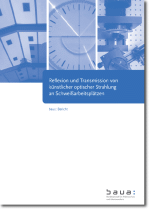Reflectance and transmittance of artificial optical radiation at welding workplaces
(in German)
Besides direct exposures to artificial UV radiation from sources like the welding arc, indirect UV irradiations at relevant workplaces caused by reflexions and transmissions can also lead to hazards with regard to safety and health of workers. While direct UV exposures were investigated thoroughly, a possible exposure increase due to indirect UV irradiation was hardly considered, so far.
Gonioreflectometric spectral measurements of a series of colorants and wall paints yielded predominantly Lambertian but also targeted directional characteristics as well as mixtures of both. The mean UV reflectances were comparably high with 3 - 19 % (colorants) and 4 - 17 % (wall paints). The corresponding biological effective reflectances were approximately 1 - 3 %. Visible and infrared radiation had much higher (unweighted) reflectances up to 90 % and even more.
Reflectance measurements by means of a newly developed field gonioreflectometer identified polystyrene, two exemplarily selected kinds of tiles (white and grey), concrete, and polished metallic surfaces as particularly strong UV reflectors. Especially the high mean UV reflectance of an electro-optical welding protection filter (22 %, unweighted) must be taken into account when performing a risk analysis. In contrast, (engineered) woods reflect slightly UV radiation, only.
Based on spectral transmittance measurements of a representative selection of 19 different welding protective clothing in conjunction with spectral irradiance data from F 2368, a new welding ultraviolet protection factor (wUPF) was developed. Its independence of the welding arc power led to the determination of seven UV standard emission spectra for structural and stainless steel as well as for aluminium depending on welding process techniques. Further analyses yielded a reduced wUPF equation solely depending on the action spectrum of interest and the spectral transmittance of the fabric.
Most of the tested welding protective clothing, especially those with middle and high grammages, provided sufficient protection against artificial UV radiation with wUPFs higher than 1,000. A comparison with (solar) sUPFs that can be used as a worst case approximation for the 19 fabrics revealed the necessity for a wUPF evaluation as well as for further research on that subject.
Please download the complete report "Reflectance and transmittance of artificial optical radiation at welding workplaces" (in German only).
Bibliographic information
Title: Reflexion und Transmission von künstlicher optischer Strahlung an Schweißarbeitsplätzen.
1. edition. Dortmund: Bundesanstalt für Arbeitsschutz und Arbeitsmedizin, 2019. pages: 110, Project number: F 2422, paper, PDF file, DOI: 10.21934/baua:bericht20190807
